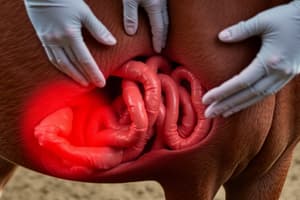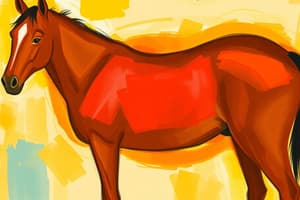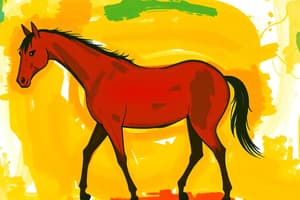Podcast
Questions and Answers
Which of the following is NOT a risk factor for colic?
Which of the following is NOT a risk factor for colic?
- Being on a specific type of anthelmintic
- Not being on a worming program
- Experiencing an increase in risk after anthelmintic administration
- Being on a regular worming program (correct)
Which of the following is a risk factor for colic?
Which of the following is a risk factor for colic?
- Being on a specific type of anthelmintic
- Not being on a worming program (correct)
- Experiencing a decrease in risk after anthelmintic administration
- Being on a regular worming program
Which of the following is a decreased risk factor for colic?
Which of the following is a decreased risk factor for colic?
- Experiencing an increase in risk after anthelmintic administration
- Being on a specific type of anthelmintic
- Not being on a worming program
- Being on a regular worming program (correct)
Which parasite was once reported to be responsible for up to 90% of all colic cases?
Which parasite was once reported to be responsible for up to 90% of all colic cases?
What condition is associated with thrombosis of the cranial mesenteric artery?
What condition is associated with thrombosis of the cranial mesenteric artery?
Since the advent of modern anthelmintics, which condition is rarely seen?
Since the advent of modern anthelmintics, which condition is rarely seen?
Which of the following is a possible cause of post-worming colic in horses?
Which of the following is a possible cause of post-worming colic in horses?
What is the main reason for post-worming colic in horses with high worm burdens?
What is the main reason for post-worming colic in horses with high worm burdens?
What treatment is sometimes undertaken alongside anthelmintic treatment in cases of Cyathostominosis?
What treatment is sometimes undertaken alongside anthelmintic treatment in cases of Cyathostominosis?
Which of the following symptoms can be associated with cyathostominosis?
Which of the following symptoms can be associated with cyathostominosis?
Which type of intussusception can be associated with cyathostominosis?
Which type of intussusception can be associated with cyathostominosis?
Which of the following statements is true about cyathostominosis?
Which of the following statements is true about cyathostominosis?
Which of the following conditions is NOT associated with Anoplocephala perfoliata infection?
Which of the following conditions is NOT associated with Anoplocephala perfoliata infection?
Which of the following is a possible complication of Anoplocephala perfoliata infection?
Which of the following is a possible complication of Anoplocephala perfoliata infection?
Which parasite was once believed to be responsible for up to 90% of all colic cases in horses?
Which parasite was once believed to be responsible for up to 90% of all colic cases in horses?
Which of the following is a potential consequence of a large burden of Parascaris equorum in horses?
Which of the following is a potential consequence of a large burden of Parascaris equorum in horses?
What are some symptoms that can be associated with a large burden of Parascaris equorum in horses?
What are some symptoms that can be associated with a large burden of Parascaris equorum in horses?
What is a potential outcome of a large burden of Parascaris equorum in horses despite surgical intervention?
What is a potential outcome of a large burden of Parascaris equorum in horses despite surgical intervention?
Which parasite can cause peri-rectal irritation and tail rubbing in horses?
Which parasite can cause peri-rectal irritation and tail rubbing in horses?
What can be difficult to treat in some clinical cases?
What can be difficult to treat in some clinical cases?
Which parasite is associated with tail rubbing in horses?
Which parasite is associated with tail rubbing in horses?
Which parasite is incidentally found during gastroscopy in horses?
Which parasite is incidentally found during gastroscopy in horses?
During which months are the eggs of Gasterophilus intestinalis often seen on horses' legs?
During which months are the eggs of Gasterophilus intestinalis often seen on horses' legs?
Are the eggs of Gasterophilus intestinalis clinically significant in most cases?
Are the eggs of Gasterophilus intestinalis clinically significant in most cases?
Flashcards
What is a decreased risk factor for colic?
What is a decreased risk factor for colic?
A regular worming program is a preventive measure against intestinal parasites, which are considered a risk factor for colic.
Which parasite was once reported to be responsible for up to 90% of all colic cases?
Which parasite was once reported to be responsible for up to 90% of all colic cases?
Strongylus vulgaris is a large strongyle that can cause serious complications, including colic.
What condition is associated with thrombosis of the cranial mesenteric artery?
What condition is associated with thrombosis of the cranial mesenteric artery?
Non-strangulating infarction is a condition where the blood supply to a portion of the intestine is blocked, but the intestine is not twisted or pinched.
Since the advent of modern anthelmintics, which condition is rarely seen?
Since the advent of modern anthelmintics, which condition is rarely seen?
Signup and view all the flashcards
Which of the following is a possible cause of post-worming colic in horses?
Which of the following is a possible cause of post-worming colic in horses?
Signup and view all the flashcards
What is the main reason for post-worming colic in horses with high worm burdens?
What is the main reason for post-worming colic in horses with high worm burdens?
Signup and view all the flashcards
What treatment is sometimes undertaken alongside anthelmintic treatment in cases of Cyathostominosis?
What treatment is sometimes undertaken alongside anthelmintic treatment in cases of Cyathostominosis?
Signup and view all the flashcards
Which of the following symptoms can be associated with cyathostominosis?
Which of the following symptoms can be associated with cyathostominosis?
Signup and view all the flashcards
Which type of intussusception can be associated with cyathostominosis?
Which type of intussusception can be associated with cyathostominosis?
Signup and view all the flashcards
Which of the following statements is true about cyathostominosis?
Which of the following statements is true about cyathostominosis?
Signup and view all the flashcards
Which of the following conditions is NOT associated with Anoplocephala perfoliata infection?
Which of the following conditions is NOT associated with Anoplocephala perfoliata infection?
Signup and view all the flashcards
Which of the following is a possible complication of Anoplocephala perfoliata infection?
Which of the following is a possible complication of Anoplocephala perfoliata infection?
Signup and view all the flashcards
Which parasite was once believed to be responsible for up to 90% of all colic cases in horses?
Which parasite was once believed to be responsible for up to 90% of all colic cases in horses?
Signup and view all the flashcards
Which of the following is a potential consequence of a large burden of Parascaris equorum in horses?
Which of the following is a potential consequence of a large burden of Parascaris equorum in horses?
Signup and view all the flashcards
What are some symptoms that can be associated with a large burden of Parascaris equorum in horses?
What are some symptoms that can be associated with a large burden of Parascaris equorum in horses?
Signup and view all the flashcards
What is a potential outcome of a large burden of Parascaris equorum in horses despite surgical intervention?
What is a potential outcome of a large burden of Parascaris equorum in horses despite surgical intervention?
Signup and view all the flashcards
Which parasite can cause peri-rectal irritation and tail rubbing in horses?
Which parasite can cause peri-rectal irritation and tail rubbing in horses?
Signup and view all the flashcards
What can be difficult to treat in some clinical cases?
What can be difficult to treat in some clinical cases?
Signup and view all the flashcards
Which parasite is associated with tail rubbing in horses?
Which parasite is associated with tail rubbing in horses?
Signup and view all the flashcards
Which parasite is incidentally found during gastroscopy in horses?
Which parasite is incidentally found during gastroscopy in horses?
Signup and view all the flashcards
During which months are the eggs of Gasterophilus intestinalis often seen on horses' legs?
During which months are the eggs of Gasterophilus intestinalis often seen on horses' legs?
Signup and view all the flashcards
Are the eggs of Gasterophilus intestinalis clinically significant in most cases?
Are the eggs of Gasterophilus intestinalis clinically significant in most cases?
Signup and view all the flashcards




